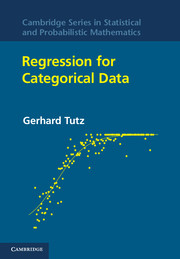Book contents
- Frontmatter
- Contents
- Preface
- 1 Introduction
- 2 Binary Regression: The Logit Model
- 3 Generalized Linear Models
- 4 Modeling of Binary Data
- 5 Alternative Binary Regression Models
- 6 Regularization and Variable Selection for Parametric Models
- 7 Regression Analysis of Count Data
- 8 Multinomial Response Models
- 9 Ordinal Response Models
- 10 Semi- and Non-Parametric Generalized Regression
- 11 Tree-Based Methods
- 12 The Analysis of Contingency Tables: Log-Linear and Graphical Models
- 13 Multivariate Response Models
- 14 Random Effects Models and Finite Mixtures
- 15 Prediction and Classification
- A Distributions
- B Some Basic Tools
- C Constrained Estimation
- D Kullback-Leibler Distance and Information-Based Criteria of Model Fit
- E Numerical Integration and Tools for Random Effects Modeling
- List of Examples
- Bibliography
- Author Index
- Subject Index
1 - Introduction
Published online by Cambridge University Press: 05 June 2012
- Frontmatter
- Contents
- Preface
- 1 Introduction
- 2 Binary Regression: The Logit Model
- 3 Generalized Linear Models
- 4 Modeling of Binary Data
- 5 Alternative Binary Regression Models
- 6 Regularization and Variable Selection for Parametric Models
- 7 Regression Analysis of Count Data
- 8 Multinomial Response Models
- 9 Ordinal Response Models
- 10 Semi- and Non-Parametric Generalized Regression
- 11 Tree-Based Methods
- 12 The Analysis of Contingency Tables: Log-Linear and Graphical Models
- 13 Multivariate Response Models
- 14 Random Effects Models and Finite Mixtures
- 15 Prediction and Classification
- A Distributions
- B Some Basic Tools
- C Constrained Estimation
- D Kullback-Leibler Distance and Information-Based Criteria of Model Fit
- E Numerical Integration and Tools for Random Effects Modeling
- List of Examples
- Bibliography
- Author Index
- Subject Index
Summary
Categorical data play an important role in many statistical analyses. They appear whenever the outcomes of one or more categorical variables are observed. A categorical variable can be seen as a variable for which the possible values form a set of categories, which can be finite or, in the case of count data, infinite. These categories can be records of answers (yes/no) in a questionnaire, diagnoses like normal/abnormal resulting from a medical examination, or choices of brands in consumer behavior. Data of this type are common in all sciences that use quantitative research tools, for example, social sciences, economics, biology, genetics, and medicine, but also engineering and agriculture.
In some applications all of the observed variables are categorical and the resulting data can be summarized in contingency tables that contain the counts for combinations of possible outcomes. In other applications categorical data are collected together with continuous variables and one may want to investigate the dependence of one or more categorical variables on continuous and/or categorical variables.
The focus of this book is on regression modeling for categorical data. This distinguishes between explanatory variables or predictors and dependent variables. The main objectives are to find a parsimonious model for the dependence, quantify the effects, and potentially predict the outcome when explanatory variables are given. Therefore, the basic problems are the same as for normally distributed response variables. However, due to the nature of categorical data, the solutions differ. For example, it is highly advisable to use a transformation function to link the linear or non-linear predictor to the mean response, to ensure that the mean is from an admissible range.
Information
- Type
- Chapter
- Information
- Regression for Categorical Data , pp. 1 - 28Publisher: Cambridge University PressPrint publication year: 2011
